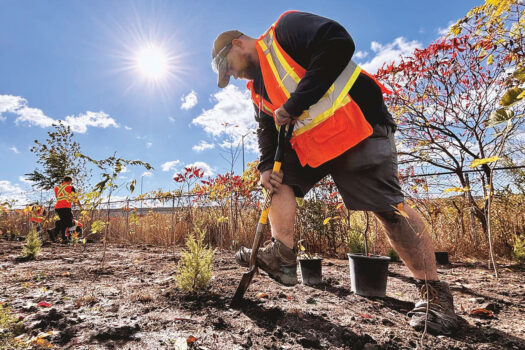By Jen Llewellyn
OMAFRA nursery crops specialist
In this fast-paced age of multi-media communication and data-hungry users, sometimes we find ourselves rushing through information before we’ve had a chance to consider it fully. Imagine yourself at a conference in a sea of posters, coming upon one entitled: ‘Response to Light Quality as a Competitive Mechanism: Biomass Partitioning Associated With Shade Avoidance Characteristics in Glycine max L. Merr. (Soybean).’ Your eyes might glaze over momentarily, and you might take a deep breath and look at the pictures before you move on. But when you meet the intelligent young author, a graduate student named Emily Green-Tracewicz from the University of Guelph, you’ll find that this research may have some implications to ornamental crops.
Everyone knows that plants respond to the reduced light levels that are the result of competition and shading from their weedy neighbours. Plants respond through stem elongation, altered flowering time and increased apical dominance in order to successfully complete their life cycle in amongst those weedy competitors. Because they shift their energy into shade avoidance-type growth, biomass allocation (e.g. yield of seeds in soybean) may be reduced. Even more significant, as in the case of ornamentals, plant morphology will change radically and undesirably.
What was novel about Emily’s poster was the discussion of a recent theory: Plants are able to detect their competitors by not only reductions in light intensity but by perceiving differences in light quality. Plant tissue reflects a different quality of light (e.g. green light) than soil, and this reflectance can actually change the quality of light that influences plant growth (e.g. the red to far red light ratio).
Essentially, the reflectance of weedy competitors reduces the amount of red light and therefore has a negative impact on photosynthesis of crop plants. Crop plants, like soybean, perceive these light quality differences and shift into “shade avoidance” mode, resulting in leggy growth that is very undesirable. The thing is, the competing plant (or weed) does not necessarily have to be shading the crop plant in order to be detected. The crop plant can actually detect weeds (in the case of this experiment, trimmed turfgrass) even when the weeds are well below the crop canopy (upward reflectance) and the root systems of the weeds are in a separate compartment. Not only did the crop plants exhibit the shade avoidance response under these conditions, there was a decrease in overall dry matter and they were developmentally delayed by 0.5-2 full trifoliate stages. The delay in development could have major implications for several crops.
I wonder if these findings could have significance for ornamental plant propagation and production. Whether it’s a carpet of seedling bittercress, moss or liverworts, are we underestimating weed control in our propagation and production systems? Could our juvenile ornamental crops be detecting (what we think are) insignificant, low growing weed populations, and could these weed populations be negatively influencing the morphology, development and biomass allocation more than we know?
Jen Llewellyn may be reached at 519-824-4120, ext. 52671, or by email at jennifer.llewellyn@ontario.ca. See her Nursery-Landscape Report: http://apps.omafra.gov.on.ca/scripts/english/crops/agriphone/index.asp






